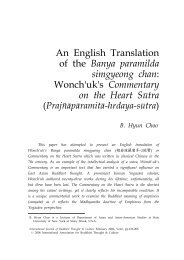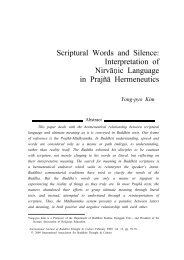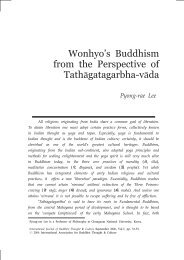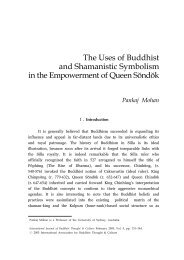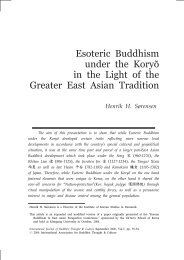The Asian Classics Input Project (ACIP): Past ... - Buddhism.org
The Asian Classics Input Project (ACIP): Past ... - Buddhism.org
The Asian Classics Input Project (ACIP): Past ... - Buddhism.org
You also want an ePaper? Increase the reach of your titles
YUMPU automatically turns print PDFs into web optimized ePapers that Google loves.
(Serial number of item, which is simply the order in which the titles are entered into thecatalog, with no other logic.)N:B6388/1(Number of the title currently, in the system of the library of the Institute or Library (ifany). <strong>The</strong> number after the slash is new and represents the position of the work in asingle volume of multiple works. This number is being added in ink on the title page asvolumes are cataloged. In the case of a loose, random page located within a volume, alowercase alphabetical letter will be placed after the slash in order not to disturb thetotal number of titles in the volume. No attempt will be made to collate these randompages into their proper volume until the catalog is completed, since this will allow thecollation to be performed accurately and quickly.)T:RDO RJE GCOD PA(Title in Tibetan as it appears on the title page, written in <strong>ACIP</strong> input code.)K:BADZRA TZTSEDIKA(Title in SansKrit as it appears on the title page in Tibetanized Sanskrit. <strong>The</strong>se titlesare primarily ornamental and often appear with incorrect spelling, or illogically dividedinto syllables. <strong>The</strong> native Tibetan operators entering the data onto diskette also havetrouble reading these difficult stacks correctly, and we can anticipate additional errorson their part. Nonetheless this data will be of some benefit to scholars seekingSanskrit equivalents.)E:LT(Extra languages appearing either on the title page alone, or throughout the whole work[such as in bilingual dictionary in interlineal format]. Current code options are: LT[Lanycha script, title page only]; LW [Lanycha script, throughout whole work]; MT andMW [same for Mongolian]; DT and DW [same for Devanagari]. No attempt is made toinput the entire extra language, but simply to indicate its presence.)X:3(X represents a seal or stamp that has been pressed onto the title page, a commonmonastic practice to identify the library or press from which the work has come. Eachtime a new seal is encountered, it is photocopied and added to a master chart and givena number. <strong>The</strong>se seals have been scanned into computer files, and are included in our



